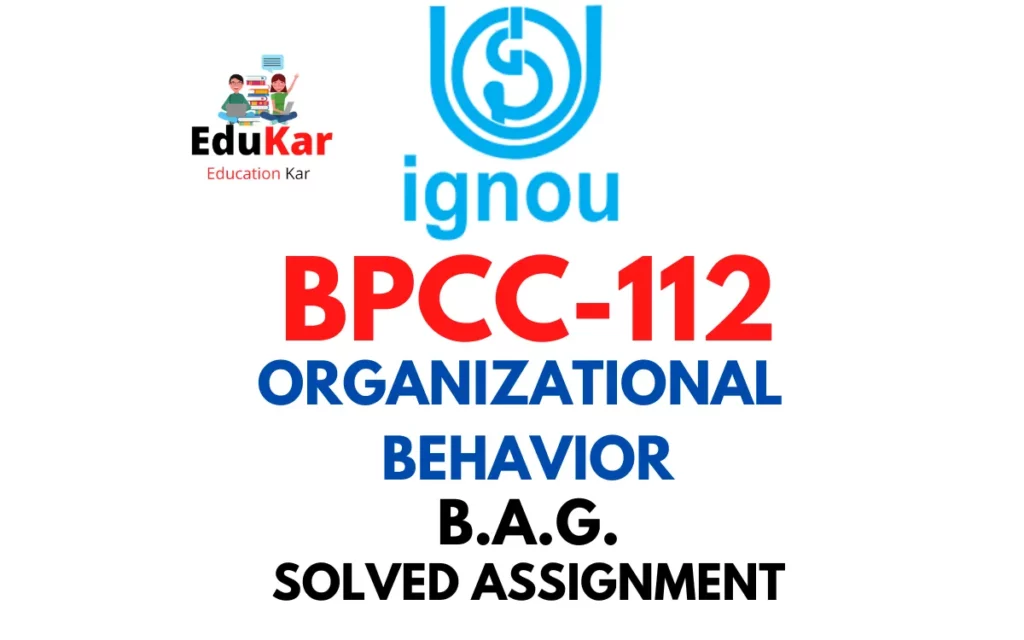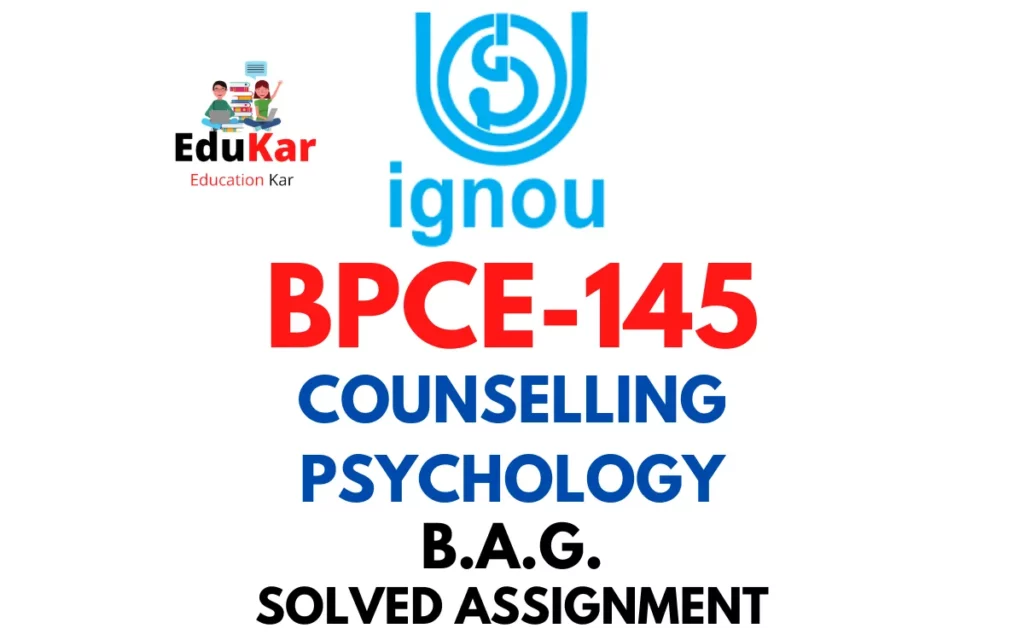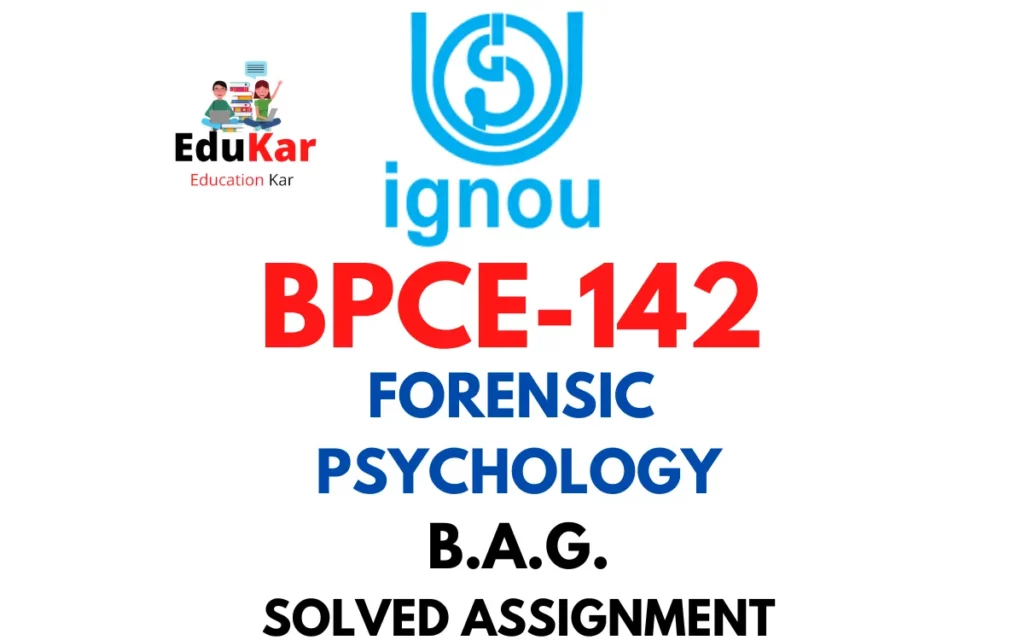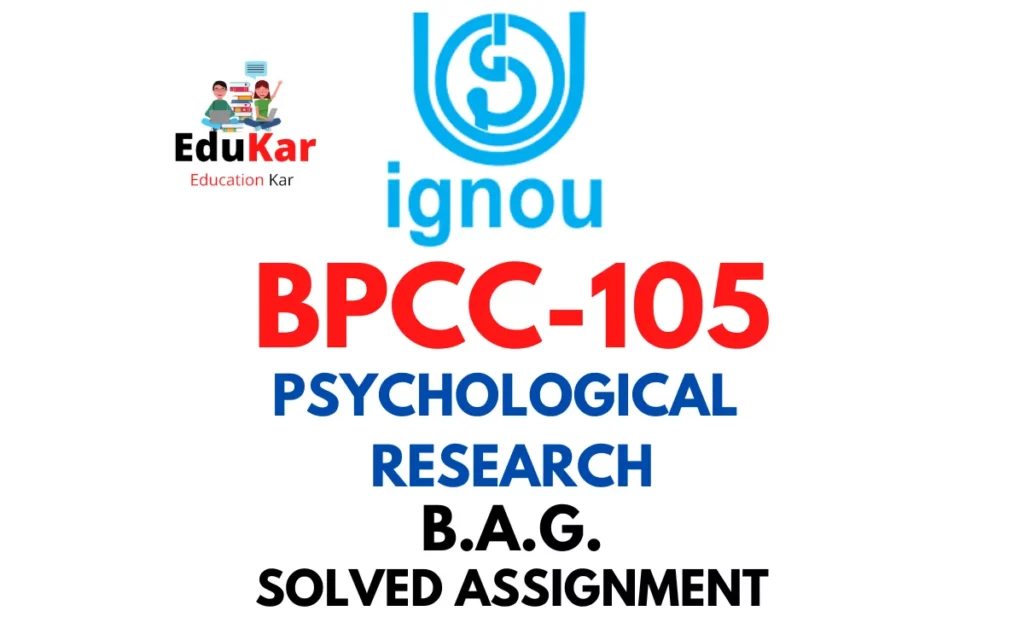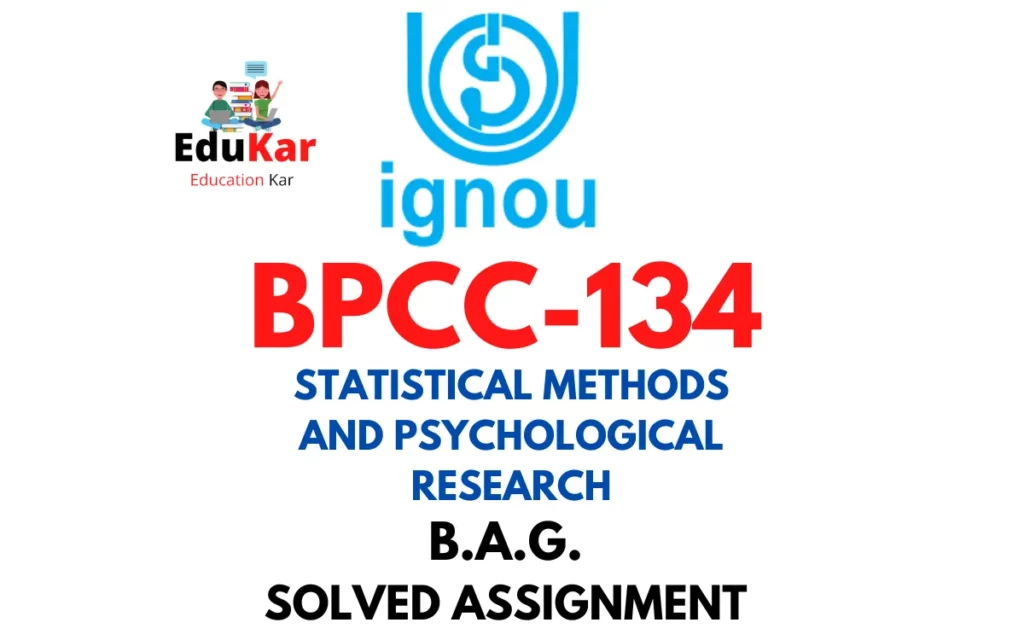Contents
- 1 Assignment One
- 2 Answer the following questions in about 500 words each. Each question carries 20 marks.
- 3 1. Explain the various models of stress with the help of suitable diagrams.
- 4 2. Describe the effect of stress on performance and productivity.
- 5 3. Explain the nature of coping and describe the coping styles.
- 6 Assignment Two
- 7 Answer the following questions in about 100 words each. Each question carries 5 marks.
- 8 4. Explain the various sources of stress with the help of suitable examples.
- 9 5. Describe perfectionism as a factor contributing to stress proneness.
- 10 6. Explain the Jacobson’s Progressive Muscle Relaxation.
- 11 7. Describe Yoga as a technique of stress management.
- 12 8. Discuss ABCDE model with the help of suitable example.
- 13 9. Describe various techniques of time management.
- 14 10. Explain effective communication as an interpersonal skill.
- 15 11. Explain JOHARI window.
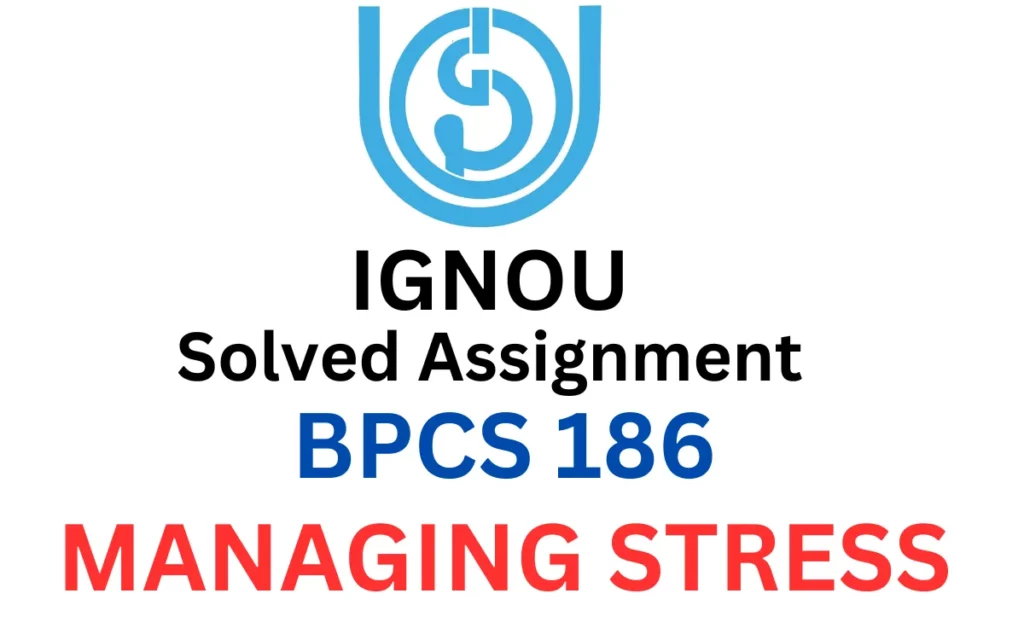
| Title | BPCS 186: IGNOU BAG Solved Assignment 2022-2023 |
| University | IGNOU |
| Degree | Bachelor Degree Programme |
| Course Code | BPCS 186 |
| Course Name | MANAGING STRESS |
| Programme Name | Bachelor of Arts (General) |
| Programme Code | BAG |
| Total Marks | 100 |
| Year | 2022-2023 |
| Language | English |
| Assignment Code | Asst /TMA /July 2022- January 2023 |
| Assignment PDF | Click Here |
| Last Date for Submission of Assignment: | For June Examination: 31st April For December Examination: 30th September |
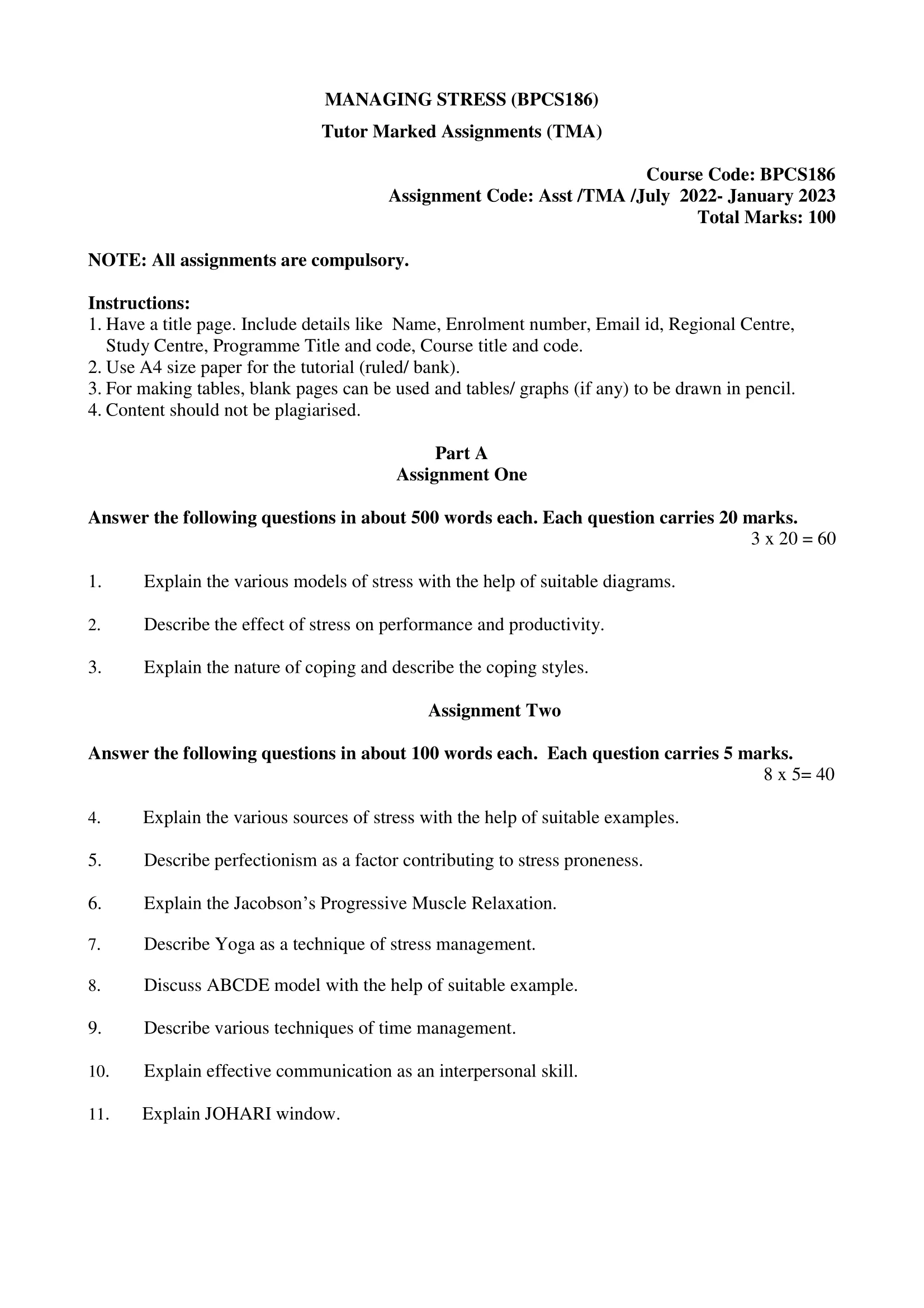
Assignment One
Answer the following questions in about 500 words each. Each question carries 20 marks.
1. Explain the various models of stress with the help of suitable diagrams.
Ans: Stress can be defined as the physical, emotional, or psychological response to a stressor, which is any event or situation that causes stress. There are various models of stress that have been proposed over the years to help understand the nature and dynamics of stress. In this essay, we will discuss three of the most widely recognized models of stress: the transactional model, the general adaptation syndrome (GAS) model, and the cognitive appraisal model.
- The Transactional Model of Stress: The transactional model of stress was proposed by Richard Lazarus and Susan Folkman in 1984. According to this model, stress is a result of the interaction between an individual and their environment. The model proposes that stress is not just a response to an external stimulus but is also a result of the individual’s cognitive appraisal of the situation. The model consists of two stages: primary appraisal and secondary appraisal.
Primary Appraisal: The primary appraisal is the initial evaluation of the situation, which determines whether it is stressful or not. In this stage, the individual evaluates the situation based on its potential to harm, challenge, or benefit them. If the situation is seen as a threat or a challenge, it is likely to be considered stressful.
Secondary Appraisal: The secondary appraisal occurs after the individual has determined that the situation is stressful. In this stage, the individual evaluates their ability to cope with the situation. If the individual feels that they have the resources to cope, the stress response may be reduced, but if they feel they do not have the resources to cope, the stress response may be increased.
- The General Adaptation Syndrome (GAS) Model: The general adaptation syndrome (GAS) model was proposed by Hans Selye in the 1950s. According to this model, stress causes a physiological response in the body that can be divided into three stages: the alarm reaction stage, the resistance stage, and the exhaustion stage.
Alarm Reaction Stage: The alarm reaction stage is the initial stage of the body’s response to stress. During this stage, the body activates its fight or flight response, which is the body’s natural response to stress. This stage is characterized by an increase in heart rate, blood pressure, and respiration rate.
Resistance Stage: The resistance stage occurs when the body tries to adapt to the stressor. During this stage, the body tries to maintain a state of readiness to respond to the stressor. The body releases hormones such as cortisol and adrenaline, which help the body to maintain its level of energy.
Exhaustion Stage: The exhaustion stage occurs when the body’s resources are depleted due to prolonged exposure to stress. During this stage, the body’s immune system becomes weakened, and the individual becomes more susceptible to illness and disease.
- The Cognitive Appraisal Model: The cognitive appraisal model was proposed by Richard Lazarus in the 1960s. According to this model, stress is a result of an individual’s cognitive appraisal of a situation. The model consists of two stages: primary appraisal and secondary appraisal.
Primary Appraisal: The primary appraisal is the initial evaluation of the situation, which determines whether it is stressful or not. In this stage, the individual evaluates the situation based on its potential to harm, challenge, or benefit them. If the situation is seen as a threat or a challenge, it is likely to be considered stressful.
Secondary Appraisal: The secondary appraisal occurs after the individual has determined that the situation is stressful. In this stage, the individual evaluates their ability to cope with the situation. If the individual feels that they have the resources to cope, the stress response may be reduced, but if they feel they do not have the resources to cope, the stress response may be increased.
2. Describe the effect of stress on performance and productivity.
Ans: Stress can have a significant impact on an individual’s performance and productivity. While a certain level of stress can be motivating and help individuals perform better, chronic or excessive stress can have detrimental effects on performance and productivity. In this essay, we will discuss the effects of stress on performance and productivity in more detail.
- Cognitive Functioning: Stress can negatively impact cognitive functioning, including attention, memory, and decision-making. When an individual is under stress, the body releases hormones such as cortisol, which can interfere with the functioning of the prefrontal cortex, the part of the brain responsible for cognitive functions. As a result, individuals may have difficulty focusing, recalling information, and making decisions.
- Work Quality: Excessive stress can also affect the quality of work an individual produces. When individuals are stressed, they may rush through tasks or make mistakes, which can negatively impact the quality of their work. Additionally, stress can affect an individual’s creativity, making it more difficult for them to come up with new ideas or solutions.
- Physical Symptoms: Stress can also manifest in physical symptoms such as headaches, fatigue, and muscle tension, which can negatively impact an individual’s ability to perform work tasks. These physical symptoms can also lead to increased absenteeism, which can further reduce productivity.
- Interpersonal Relations: Stress can also negatively impact interpersonal relations, which can have an indirect impact on performance and productivity. When individuals are stressed, they may become irritable, moody, or withdrawn, which can affect their relationships with coworkers or customers. This can lead to a decrease in job satisfaction and can also impact the quality of work produced.
- Burnout: Chronic stress can lead to burnout, a state of physical and emotional exhaustion characterized by feelings of cynicism and a reduced sense of accomplishment. Burnout can lead to decreased motivation and productivity, and can also increase the likelihood of absenteeism and turnover.
3. Explain the nature of coping and describe the coping styles.
Ans: Coping can be defined as the process of dealing with, managing, and adapting to stress, adversity, or difficult situations. Coping is a vital aspect of human functioning, as it helps individuals to handle and overcome the challenges they face in life. Coping can be seen as a response to stress, and it involves both cognitive and behavioral efforts aimed at reducing the negative impact of a stressful situation. Coping can be seen as a dynamic process that is influenced by a range of factors, including the individual’s personality, the nature of the stressor, the social support available to the individual, and the coping strategies that are employed.
Coping styles can be described as the different ways in which individuals respond to stress and difficult situations. There are several coping styles that individuals may employ, and these can be broadly categorized into two main types: problem-focused coping and emotion-focused coping. Problem-focused coping involves efforts to directly address the problem or stressor, while emotion-focused coping involves efforts to manage the emotions associated with the stressor.
Problem-focused coping is an active and problem-solving-oriented approach to coping. This type of coping style involves taking concrete steps to address the problem or stressor. For example, problem-focused coping may involve seeking information about the stressor, developing a plan of action, and taking steps to implement that plan. This coping style is often effective in situations where the individual has some control over the stressor, and where the stressor can be addressed through concrete actions.
Emotion-focused coping, on the other hand, is a more passive and emotion-regulation-oriented approach to coping. This type of coping style involves efforts to manage the emotional response to the stressor, rather than directly addressing the stressor itself. Emotion-focused coping may involve strategies such as cognitive reappraisal, seeking social support, or engaging in activities that distract from the stressor. This coping style is often effective in situations where the individual has little control over the stressor, or where the stressor cannot be directly addressed.
In addition to these broad categories of coping styles, there are also several specific coping strategies that individuals may employ. These strategies include problem-solving, planning, positive reappraisal, acceptance, avoidance, denial, and venting. Problem-solving and planning involve actively addressing the stressor and developing a plan to address it. Positive reappraisal involves finding positive aspects of the stressor or situation. Acceptance involves accepting the stressor and finding ways to cope with it. Avoidance involves avoiding the stressor or situation altogether. Denial involves denying that the stressor exists or minimizing its impact. Venting involves expressing emotions related to the stressor.
Assignment Two
Answer the following questions in about 100 words each. Each question carries 5 marks.
4. Explain the various sources of stress with the help of suitable examples.
Ans: Stress can originate from various sources, including environmental, psychological, and physiological factors. Environmental stressors include noise pollution, traffic, and crowding. For instance, living in a noisy and polluted urban area can lead to stress due to constant exposure to loud noises and poor air quality. Psychological stressors involve interpersonal conflict, job pressure, and financial stress. For example, a worker may experience stress when facing a high workload, tight deadlines, or job insecurity. Physiological stressors include illness, injury, or physical exhaustion. For instance, an athlete may experience stress when trying to perform at a high level while dealing with pain or fatigue. Understanding the different sources of stress is critical to developing effective stress management strategies.
5. Describe perfectionism as a factor contributing to stress proneness.
Ans: Perfectionism is a personality trait characterized by the pursuit of high standards and the tendency to be overly critical of one’s own performance. While striving for excellence can be motivating, perfectionism can lead to stress proneness. Perfectionists tend to set unrealistic expectations for themselves, leading to feelings of inadequacy and self-doubt when they cannot meet these standards. They may engage in constant self-criticism and rumination over perceived failures, leading to negative emotions such as anxiety and depression. Perfectionists may also experience stress when faced with ambiguous situations or when things do not go according to plan. To manage stress related to perfectionism, it is essential to practice self-compassion, realistic goal-setting, and learning to accept mistakes as a natural part of the learning process.
6. Explain the Jacobson’s Progressive Muscle Relaxation.
Ans: Jacobson’s Progressive Muscle Relaxation is a relaxation technique that involves the systematic tensing and relaxing of muscle groups throughout the body. The goal of this technique is to help individuals become more aware of their physical sensations and to reduce muscle tension, which is often associated with stress and anxiety.
The technique involves two main steps. In the first step, the individual tenses a specific muscle group for about 5-10 seconds, such as clenching their fists or tightening their shoulders. In the second step, the individual releases the tension and allows the muscles to relax completely for about 10-20 seconds. The process is repeated with different muscle groups throughout the body, starting from the feet and working up to the head.
By regularly practicing Jacobson’s Progressive Muscle Relaxation, individuals can learn to recognize when they are experiencing muscle tension and can apply the technique to help alleviate the physical symptoms of stress and anxiety. The technique is easy to learn and can be practiced almost anywhere, making it a popular relaxation technique for those looking to manage stress and anxiety.
7. Describe Yoga as a technique of stress management.
Ans: Yoga is a technique of stress management that involves physical postures, breathing exercises, and meditation. Yoga is designed to promote relaxation, reduce stress, and improve overall well-being. The practice of yoga involves a combination of physical movements and mental focus, which can help individuals to become more aware of their physical and mental states and to manage their stress response more effectively.
Yoga can help to reduce stress by promoting physical relaxation and reducing muscle tension. The physical postures, or asanas, are designed to stretch and strengthen the body, which can help to alleviate physical symptoms of stress such as tension headaches, back pain, and muscle tightness. The breathing exercises, or pranayama, can help to calm the mind and promote relaxation, which can help to reduce feelings of anxiety and stress.
Yoga also incorporates meditation techniques, which can help individuals to become more aware of their thoughts and emotions and to develop a more positive outlook on life. By practicing mindfulness and focusing on the present moment, individuals can learn to manage their stress response more effectively and to develop a greater sense of inner peace and well-being.
8. Discuss ABCDE model with the help of suitable example.
Ans: The ABCDE model is a cognitive behavioral therapy (CBT) technique that helps individuals to identify and challenge negative thoughts and beliefs that may be contributing to their stress or emotional distress. The model involves breaking down negative thoughts and beliefs into five main components:
A – Activating event: The event or situation that triggered the negative thought or belief.
B – Beliefs: The negative thought or belief about the event or situation.
C – Consequences: The emotional and behavioral consequences of the negative thought or belief.
D – Dispute: The process of challenging and disputing the negative thought or belief.
E – Effects: The effects of disputing the negative thought or belief, including a more positive and realistic outlook.
For example, let’s say someone receives negative feedback on a work project (activating event). They may have the negative belief that they are not good enough and will never succeed in their job (belief). This negative belief can lead to feelings of anxiety and self-doubt (consequences). Using the ABCDE model, the individual can challenge and dispute this belief by asking questions such as “Is it really true that I am not good enough?” or “What evidence do I have to support this belief?” (dispute). By doing so, they may come to realize that this negative belief is not entirely accurate or helpful (effects). They may then be able to develop a more positive and realistic belief, such as “I may have made some mistakes, but I can learn from them and improve in the future.”
Overall, the ABCDE model is a useful tool for identifying and challenging negative thoughts and beliefs, which can help individuals to manage their stress and improve their emotional well-being.
9. Describe various techniques of time management.
Ans: Effective time management involves prioritizing tasks, setting realistic goals, and allocating time to different activities based on their level of importance and urgency. Here are some techniques that can help with time management:
- To-do lists: Create a daily or weekly to-do list that outlines the tasks that need to be accomplished. This can help to prioritize tasks and ensure that nothing is forgotten.
- Prioritization: Determine the level of importance and urgency of each task and prioritize them accordingly. This can help to ensure that the most important tasks are completed first.
- Time blocking: Allocate specific time slots for different tasks, such as work-related tasks, exercise, family time, and hobbies. This can help to ensure that enough time is dedicated to each activity.
- Pomodoro technique: Break tasks into 25-minute intervals, with short breaks in between. This can help to improve focus and productivity.
- Delegation: Delegate tasks to others, when possible, to free up time for other important tasks.
- Avoid multitasking: Focus on one task at a time, as multitasking can lead to decreased productivity and increased stress.
- Set realistic goals: Set realistic goals that can be achieved within a specific time frame. This can help to avoid feeling overwhelmed and increase motivation.
- Learn to say no: It is important to recognize when saying yes to a request will interfere with other important tasks. Learning to say no can help to prioritize tasks and manage time effectively.
10. Explain effective communication as an interpersonal skill.
Ans: Effective communication is a crucial interpersonal skill that involves the ability to convey ideas, thoughts, and feelings in a clear, concise, and respectful manner. It involves the exchange of information between two or more people and is essential for building and maintaining positive relationships with others.
Effective communication involves several key components, including:
- Listening: Active listening involves paying attention to what others are saying and showing an interest in their thoughts and feelings.
- Clarity: Communicating in a clear and concise manner, using simple and easy-to-understand language.
- Empathy: Understanding and considering the other person’s perspective, thoughts, and feelings.
- Non–verbal communication: Paying attention to non-verbal cues, such as body language, tone of voice, and facial expressions.
- Feedback: Providing feedback in a constructive and respectful manner, while being open to receiving feedback from others.
- Respect: Communicating in a respectful and courteous manner, while avoiding judgment, criticism, or negativity.
Effective communication is essential for building strong interpersonal relationships, both in personal and professional settings. It can help to resolve conflicts, establish trust, and promote collaboration and teamwork. By developing effective communication skills, individuals can improve their ability to express their thoughts and feelings, as well as understand and appreciate the perspectives of others.
11. Explain JOHARI window.
Ans: The Johari Window is a model used to help individuals better understand their communication and relationships with others. It was developed by psychologists Joseph Luft and Harry Ingham in 1955. The model is named after its creators (Johari being a combination of their first names Joe and Harry).
The model is a four-quadrant grid, with the dimensions being the information known to oneself (what is known to me) and the information known to others (what is known to others). The quadrants are:
- Open Area or Arena: This quadrant represents the information that is known to both the individual and others. It includes things like strengths, weaknesses, skills, experiences, and knowledge that are shared openly.
- Blind Area or Blindspot: This quadrant represents the information that is not known to the individual but is known to others. It includes things like habits, behaviors, or attitudes that the individual may be unaware of, but that others can see.
- Hidden Area or Façade: This quadrant represents the information that is known to the individual but is not shared with others. It includes things like fears, insecurities, and other personal information that the individual may choose to keep private.
- Unknown Area or Unknown: This quadrant represents the information that is unknown to both the individual and others. It includes things like undiscovered talents, repressed emotions, or other aspects of the individual that are yet to be revealed.
The goal of the JOHARI Window is to increase the size of the open area, which can be achieved through increased self-awareness and effective communication with others. By sharing more about themselves with others, individuals can reduce the size of the hidden area and increase the size of the open area. Similarly, by receiving feedback from others, individuals can reduce the size of the blind area and increase their self-awareness.
How to Download BPCS 186 Solved Assignment?
You can download it from the www.edukar.in, they have a big database for all the IGNOU solved assignments.
Is the BPCS 186 Solved Assignment Free?
Yes this is absolutely free to download the solved assignment from www.edukar.in
What is the last submission date for BPCS 186 Solved Assignment?
For June Examination: 31st April, For December Examination: 30th October


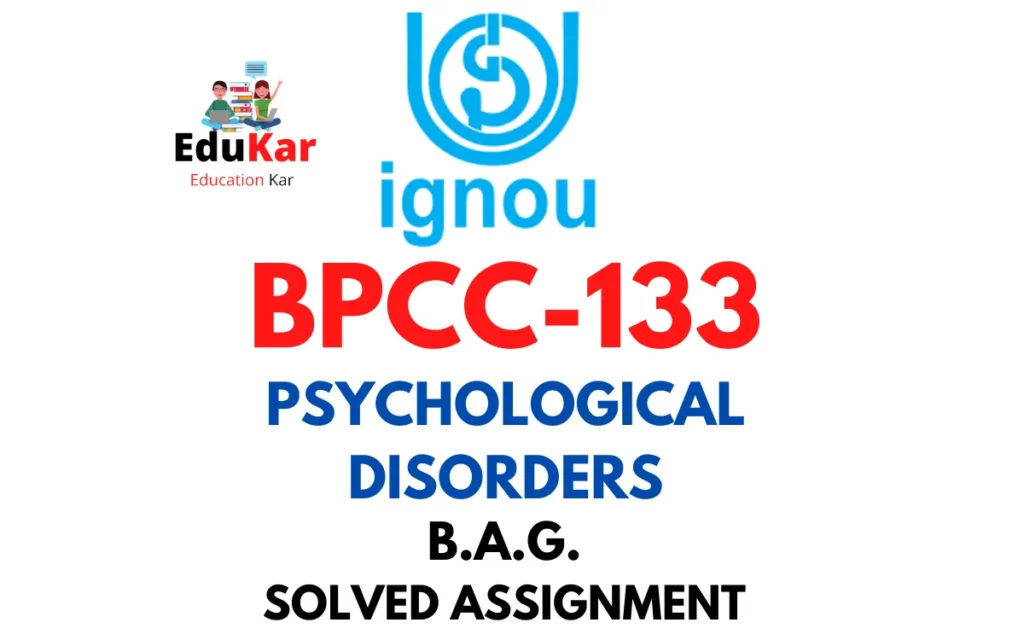
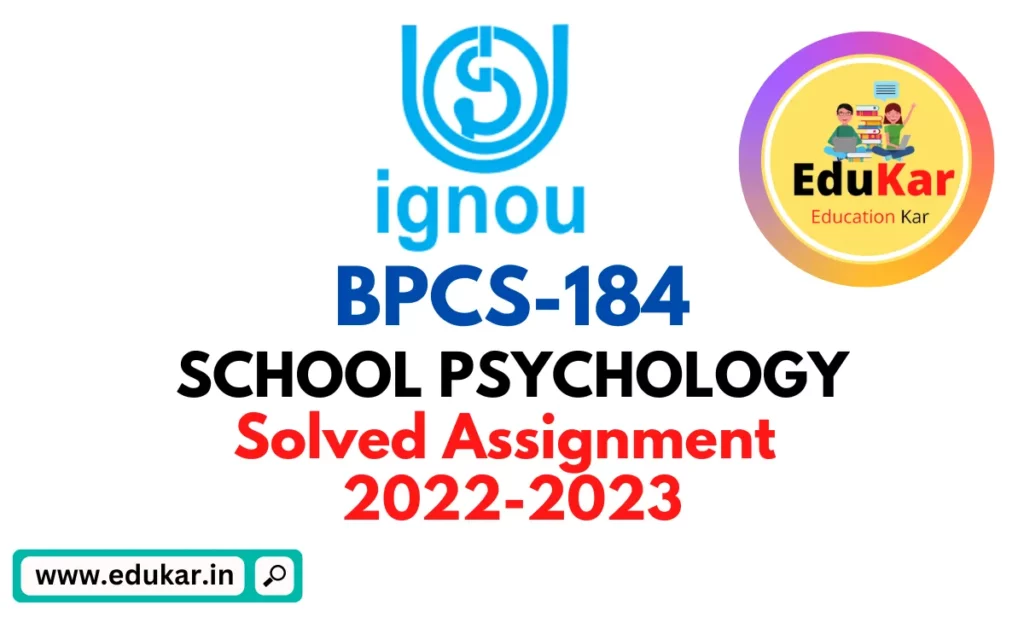
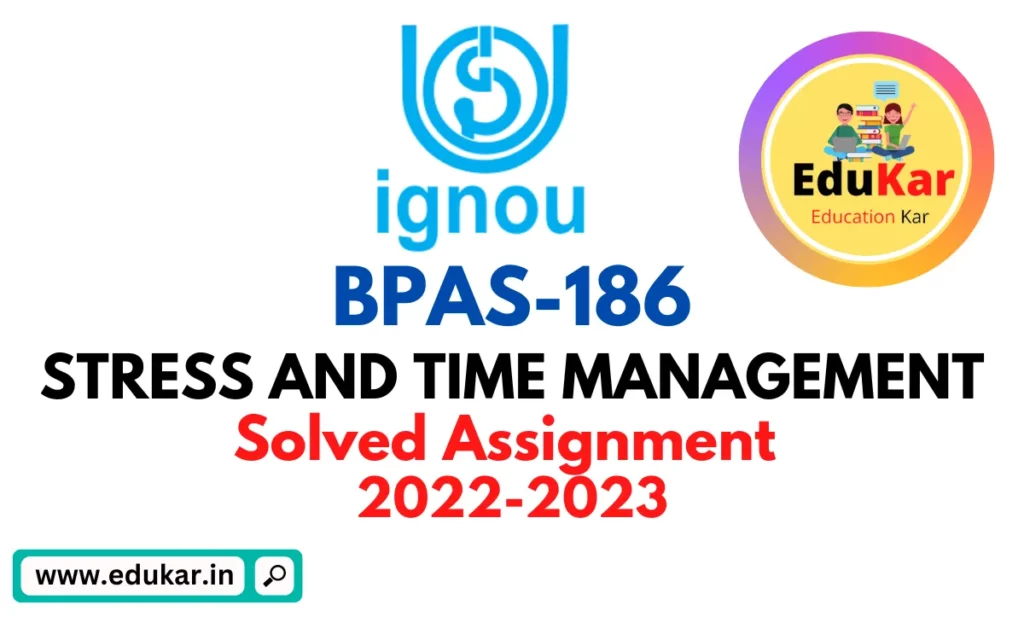
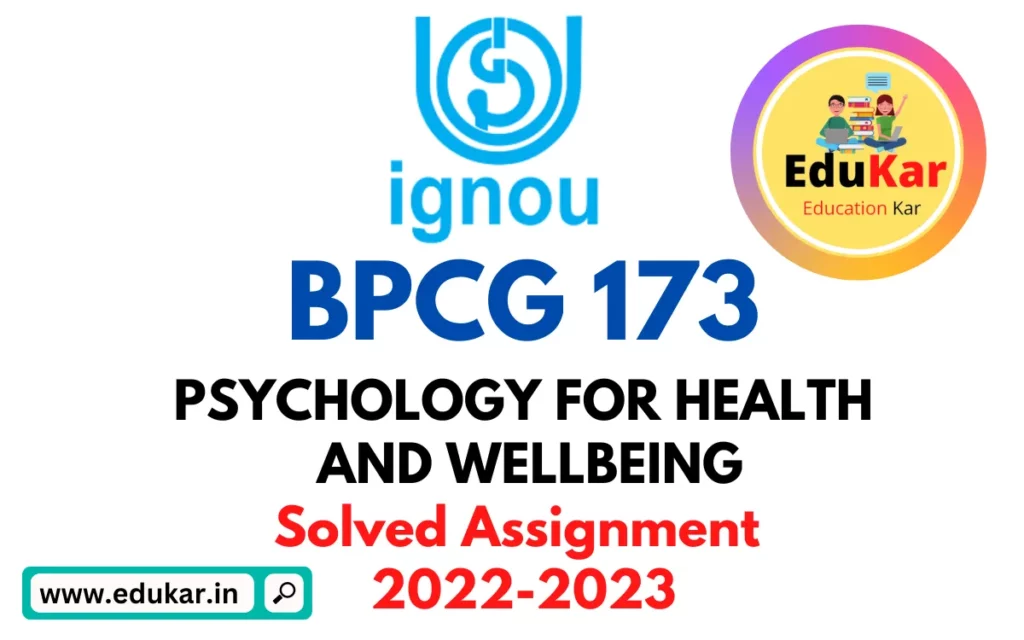
![[Solved Assignment] BPCS 188-APPLICATIONS OF SOCIAL PSYCHOLOGY (IGNOU-BAG) 2022-2023 BPCS 188-APPLICATIONS OF SOCIAL PSYCHOLOGY IGNOU BAG Solved Assignment 2022-2023](https://edukar.in/wp-content/uploads/2023/01/BPCS-188-APPLICATIONS-OF-SOCIAL-PSYCHOLOGY-IGNOU-BAG-Solved-Assignment-2022-2023-1024x640.webp)
